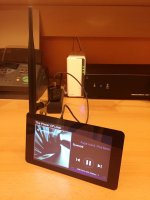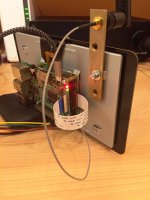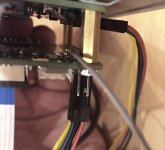No need to measure, it is simply 10k per volt... so 50k on your board
3,3 volt is 33k
Thanks!
I did the swap yesterday from kali/isolator - dddac and can confirm that ian fifo with the Accusilicon clocks is an audible upgrade in my system. It is even worth to try rpi-allo isolator (slave mode)- ian fifo II.
Interesting. I prefer the Allo Isolator/Kali (upgraded NDK clocks) powered by Lifepo4 batteries, to Ian’s Isolator/Fifo Pi (Pulsar Clock) powered by Lifepo4. I need to try the FifoPi again. There’s little is any difference between the isolator boards in my view. I only hear the difference when I run the Pi/clocker board with no Isolator.
Maybe I should dig out my Acko S03/BBB to try as well, but there are so many permutations if you take power supply and clock options into account
Hello,
I asked Ian some questions about his circuits that can be used in combination with the DDDAC. If answers come i will tell you all about it.
greetings,Eduard
what do you mean with this Eduard?
Hello Doede,
I just asked some questions to make things more clearer for me and some things i would like to know to make the right decisions. I also mentioned that in this thread there are some people started to use fifopi and who might eventually also be interested in a lifepo4 supply.
If this information is useful i can just copy and paste it here.
Greetings, Eduard
P.s i could try if i can copy and paste the message into a post.
I just asked some questions to make things more clearer for me and some things i would like to know to make the right decisions. I also mentioned that in this thread there are some people started to use fifopi and who might eventually also be interested in a lifepo4 supply.
If this information is useful i can just copy and paste it here.
Greetings, Eduard
P.s i could try if i can copy and paste the message into a post.
Hello Doede,
I just asked some questions to make things more clearer for me and some things i would like to know to make the right decisions. I also mentioned that in this thread there are some people started to use fifopi and who might eventually also be interested in a lifepo4 supply.
If this information is useful i can just copy and paste it here.
Greetings, Eduard
P.s i could try if i can copy and paste the message into a post.
Just buy, try and find out.
Interesting. I prefer the Allo Isolator/Kali (upgraded NDK clocks) powered by Lifepo4 batteries, to Ian’s Isolator/Fifo Pi (Pulsar Clock) powered by Lifepo4. I need to try the FifoPi again. There’s little is any difference between the isolator boards in my view. I only hear the difference when I run the Pi/clocker board with no Isolator.
Maybe I should dig out my Acko S03/BBB to try as well, but there are so many permutations if you take power supply and clock options into account.
I don’t think Fifopi with stock clocks is much better than Kali, but replace them with the Accusilicon clocks, oh la la...;-)
Hello,
I asked Ian some questions about his circuits that can be used in combination with the DDDAC. If answers come i will tell you all about it.
greetings,Eduard
Ask Doede, he’s the man and designer of our beloved dac.
I don’t think Fifopi with stock clocks is much better than Kali, but replace them with the Accusilicon clocks, oh la la...;-)
Indeed my observation as well. I tried both and the FiFoPi with the accusilicon clocks is clearly the most musical
I spent a little time to prepare for WLAN streaming. The PI itself is totally useless as of the micro on board antenna. I read this nice story and actually mounted an UFL connector at the back of the PI and added a 10€ Ebay Antenna with the result that 10 meters from Router with walls and refrigerator in between I could stream display information + 192kHz track without problems. The PI already makes problems at a few meters away  Nice mod and no need for expensive Ethernet cables? Still need to compare of course….
Nice mod and no need for expensive Ethernet cables? Still need to compare of course….
link to UFL mod
easier mod without UFL, with some background
my pics:
link to UFL mod
easier mod without UFL, with some background
my pics:
Attachments
Last edited:
I don’t think Fifopi with stock clocks is much better than Kali, but replace them with the Accusilicon clocks, oh la la...;-)
Try NDK SDA clocks on the Kali. They’re a vast improvement over the supplied clocks. I just wish batteries were not sounding better than anything else I’ve tried to power the isolator or clocks....this may force me down path of Ian’s battery management board. Too much hassle removing batteries, charging them and installing again.
I spent a little time to prepare ... The PI itself ... my pics
Are those jumper wires from the RPi pin header going to the IAN FiFo? Wouldn't it be better to keep those I2S connections as short as possible by plugging the IAN board right onto the RPi?
Are those jumper wires from the RPi pin header going to the IAN FiFo? Wouldn't it be better to keep those I2S connections as short as possible by plugging the IAN board right onto the RPi?
watch closely… this is just the remote control with its own PI3. No FiFoPi attached. The jumpers are V+ and GND and the two serial control signals for the LCD screen. I uses this as a test with "Raspberry I2S" in ropieee to see if the 192kHz stream reaches the PI board. Normally the remote PI/Screen will only be configured with "no HAT"
So in my DAC, I will most probably and finally end up with two PI's …. One with FiFoPi & antenna (and yes, the FiFoPi is plugged on top of the PI ) and one with the touchscreen for basic control and a "now playing" kind of function
Last edited:
watch closely… this is just the remote control with its own PI3. No FiFoPi attached. The jumpers are V+ and GND and the two serial control signals for the LCD screen. I uses this as a test with "Raspberry I2S" in ropieee to see if the 192kHz stream reaches the PI board. Normally the remote PI/Screen will only be configured with "no HAT"
Ok, I see. I thought the RPi on the photo feeds the FiFo board.
So in my DAC, I will most probably and finally end up with two PI's …. One with FiFoPi & antenna (and yes, the FiFoPi is plugged on top of the PI ) and one with the touchscreen for basic control and a "now playing" kind of function
Is that a little spoiler? Is this a hint saying that the RPi + IAN FiFo is the way to go in terms of sound quality?
Can't you connect the IAN FiFo and the screen/display to the same RPi? Using two RPi computers for this seems complicated.
I have stopped worrying about displays at my HiFi devices. Roon, Volumio etc. do a very good job in telling me what's going on and in controlling the music over my smartphone or tablet in my seat (or in the kitchen or garage or ...). Since the whole music system has moved into the home computer network I really have no need for a display or controls on the DDDAC box anymore.
Allow me to retract my previous comment about Kali being better in my system than FifoPi  I had forgotten to physically bypass two LDO's on bottom of FifoPi when powering it with a 3.3v battery. Now the FifoPi with Pulsar clock sounds superior. Be careful if you do remove the LDO's to apply no more than 3.3v power to the FifoPi, or the magic smoke might be released.
I had forgotten to physically bypass two LDO's on bottom of FifoPi when powering it with a 3.3v battery. Now the FifoPi with Pulsar clock sounds superior. Be careful if you do remove the LDO's to apply no more than 3.3v power to the FifoPi, or the magic smoke might be released.
Allow me to retract my previous comment about Kali being better in my system than FifoPiI had forgotten to physically bypass two LDO's on bottom of FifoPi when powering it with a 3.3v battery. Now the FifoPi with Pulsar clock sounds superior. Be careful if you do remove the LDO's to apply no more than 3.3v power to the FifoPi, or the magic smoke might be released.
Thanks for the feedback ! pls share a pic of before and after how you did this
Thanks for the feedback ! pls share a pic of before and after how you did this
It's R58 and R59 on bottom of the FifoPi Doede. Put a link across each one as circled in this (before) pic:
https://www.diyaudio.com/forums/pc-...ssions-tweaks-mods-hints-123.html#post6054703
Hmm, I just had a thought... people seem to try and avoid LDOs or other voltage regulators (78xx and LFxx), possibly because their load response is affected by their built-in feedback mechanisms. However, we need to get well-defined voltages from our power supplies to work with the DDDAC and the USB/I2S/RPi/whatever-boards around it.
When it comes to making a power supply with a defined output voltage, the alternative to regulators with feedback would be to use a Zener diode as a voltage reference, which does not have any feedback. This would give a stable voltage, but without the regulation/feedback. Maybe add a transistor to buffer the Zener voltage (similar as with a capacitance multiplier: Capacitance Multiplier Power Supply Filter).
Now, Zeners are noisy, so the output voltage would be noisy, too. The noise can filtered with an RC filter. Or one could use LEDs instead. Or, since batteries seem to be en vogue here, how about using a battery? Would it make sense to use a battery as a DC voltage reference in a power supply in the same way as using battery bias in tube amps? Thoughts?
When it comes to making a power supply with a defined output voltage, the alternative to regulators with feedback would be to use a Zener diode as a voltage reference, which does not have any feedback. This would give a stable voltage, but without the regulation/feedback. Maybe add a transistor to buffer the Zener voltage (similar as with a capacitance multiplier: Capacitance Multiplier Power Supply Filter).
Now, Zeners are noisy, so the output voltage would be noisy, too. The noise can filtered with an RC filter. Or one could use LEDs instead. Or, since batteries seem to be en vogue here, how about using a battery? Would it make sense to use a battery as a DC voltage reference in a power supply in the same way as using battery bias in tube amps? Thoughts?
@mbrennwa: Hi ... well, in my experience batteries are second-to-none in terms of "silence", dynamics and overall stability of the sound reproduction. The challenge can be to give the batteries good working conditions - not least LiFePO4 & Li-ion batteries which again IME need very low noise over-voltage stabilisation on each cell. They don't distribute the charge voltage equally between the batteries as a lead acid battery tends to do. Also, some DACs prefer/must be powered up at the same time on all PSU voltages ... which may be a challenge with batteries ...
Also, IME the capacitance multiplier is a quite good PSU approach, however, the effective "PSRR" depends on the damping of the "collector" part of the transistor (Early value) and the LED-zener/resistor/capacitor network leading to the base of the transistor. One may of course use Sziklai-like transistor configurations - but this is something I do not have experience with ....
Cheers,
Jesper
Also, IME the capacitance multiplier is a quite good PSU approach, however, the effective "PSRR" depends on the damping of the "collector" part of the transistor (Early value) and the LED-zener/resistor/capacitor network leading to the base of the transistor. One may of course use Sziklai-like transistor configurations - but this is something I do not have experience with ....
Cheers,
Jesper
- Home
- Source & Line
- Digital Line Level
- A NOS 192/24 DAC with the PCM1794 (and WaveIO USB input)


